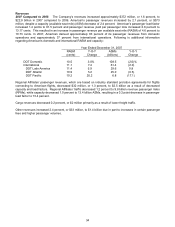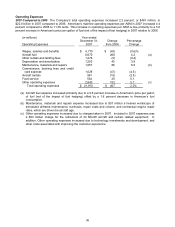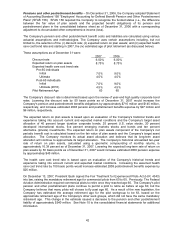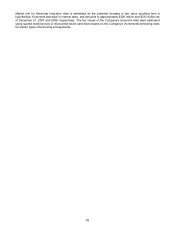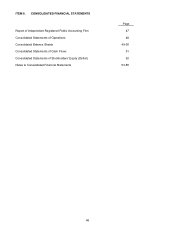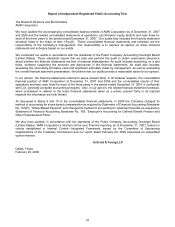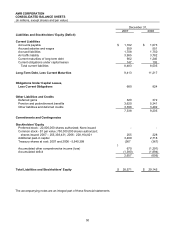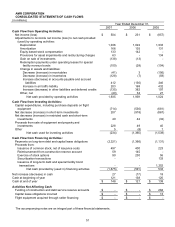American Airlines 2007 Annual Report Download - page 44
Download and view the complete annual report
Please find page 44 of the 2007 American Airlines annual report below. You can navigate through the pages in the report by either clicking on the pages listed below, or by using the keyword search tool below to find specific information within the annual report.41
Frequent flyer program – American uses the incremental cost method to account for the portion of its
frequent flyer liability incurred when AAdvantage members earn mileage credits by flying on American or its
regional affiliates. In 2007, the Company changed its policy regarding the life of AAdvantage mileage
credits. Effective December 15, 2007, AAdvantage members now must have mileage earning or
redemption activity at least once every eighteen (18) months in order to remain active and retain their miles.
Prior to this change, mileage credits automatically expired after thirty-six (36) months of inactivity in the
AAdvantage member’s account. The Company recorded a one-time benefit of $39 million as a component
of passenger revenue in 2007 to reflect the impact of the additional miles expiring upon the change of
expiration period for AAdvantage mileage.
The Company considers breakage in its incremental cost calculation and recognizes breakage on
AAdvantage miles sold over the estimated period of usage for sold miles that are ultimately redeemed. The
Company calculates its breakage estimate using separate breakage rates for miles earned by flying on
American and miles earned through other companies who have purchased AAdvantage miles for
distribution to their customers, due to differing behavior patterns.
Management considers historical patterns of account breakage to be a useful indicator when estimating
future breakage. Future program redemption opportunities can significantly alter customer behavior from
historical patterns with respect to inactive accounts. Such changes may result in material changes to the
deferred revenue balance, as well as recognized revenues from the program.
American includes fuel, food, passenger insurance and reservations/ticketing costs in the calculation of
incremental cost. These estimates are generally updated based upon the Company’s 12-month historical
average of such costs. American also accrues a frequent flyer liability for the mileage credits expected to
be used for travel on participating airlines based on historical usage patterns and contractual rates.
Revenue earned from selling AAdvantage miles to other companies is recognized in two components. The
first component represents the revenue for air transportation sold and is valued at fair value. This revenue
is deferred and recognized over the period the mileage is expected to be used, which is currently estimated
to be 28 months. The second revenue component, representing the marketing services sold, is recognized
as related services are provided.
The Company’s total liability for future AAdvantage award redemptions for free, discounted or upgraded
travel on American, American Eagle or participating airlines as well as unrecognized revenue from selling
AAdvantage miles to other companies was approximately $1.6 billion at both December 21, 2007 and 2006
(and is recorded as a component of Air traffic liability in the consolidated balance sheets), representing 19.2
percent and 18.3 percent of AMR's total current liabilities, at December 31, 2007 and 2006, respectively.
The number of free travel awards used for travel on American and American Eagle was 2.6 million in 2007
and 2.6 million in 2006 representing approximately 7.5 percent of passengers boarded in each year. The
Company believes displacement of revenue passengers is minimal given the Company’s load factors, its
ability to manage frequent flyer seat inventory, and the relatively low ratio of free award usage to total
passengers boarded.
Changes to the percentage of the amount of revenue deferred, deferred recognition period, percentage of
awards expected to be redeemed for travel on participating airlines, breakage or cost per mile estimates
could have a significant impact on the Company’s revenues or incremental cost accrual in the year of the
change as well as in future years.
Stock Compensation – Effective January 1, 2006, the Company adopted the fair value recognition
provisions of Statement of Financial Accounting Standards No. 123(R) "Share-Based Payment". The
Company grants awards under its various share based payment plans and utilizes option pricing models or
fair value models to estimate the fair value of its awards. Certain awards contain a market performance
condition, which is taken into account in estimating the fair value on the date of grant. The fair value of
those awards is estimated using a Monte Carlo valuation model that estimates the probability of the
potential payouts of these awards, using the historical volatility of the Company's stock and the stock of
other carriers in the competitor group. The Company accounts for these awards over the three year term of
the award based on the grant date fair value, provided adequate shares are available to settle the awards.
For awards where adequate shares are not anticipated to be available or that only permit settlement in
cash, the fair value is re-measured each reporting period.





